What is AmplifyRP® Isothermal Amplification?
It is end-point isothermal nucleic acid amplification and detection technology that achieves the sensitivity and specificity of PCR based testing methods, with clear advantages. Unlike PCR, AmplifyRP Acceler8 does not require thermal cycling. The entire process gets completed at a single operating temperature (39°C) using a portable heating block. Moreover, AmplifyRP® does not require a DNA or RNA purification step. Crude sample extracts can be prepared using a simple extraction buffer and can be tested directly. This makes the testing process very simple and saves the end user’s valuable time.
Agdia AmplifyRP® comes in two different formats- Acceler8 and XRT
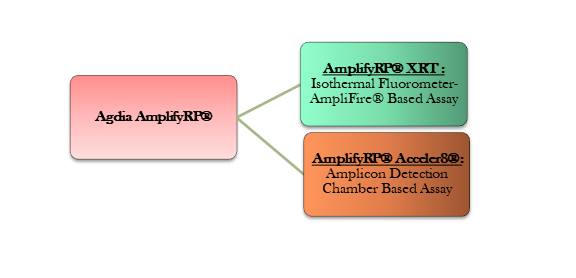
| Check all AmplifyRP® kits available for various pathogens in the table below | ||||||
| Pathogen | AmplifyRP® XRT Kits | AmplifyRP® Acceler8® Kits | Pathogen | AmplifyRP® XRT Kits | AmplifyRP® Acceler8® Kits | |
|---|---|---|---|---|---|---|
| AmplifyRP Discovery kit | XCS 99200 | Hop stunt viroid | XCS 64200 | |||
| Banana bunchy top virus | XCS 24700 | ACS 24700 | Lettuce chlorosis virus | XCS 44200 | ||
| Beet curly top virus | XCS 11000 | ACS 85601 | ||||
| Candidatus Liberibacter asiaticus | ACS 15400 | Phytophthora ramorum | XCS 93400 | |||
| Clavibacter michiganensis subsp. michiganensis | XCS 44001 | Phytoplasma solani BN | XCS 89000 | |||
| Clavibacter michiganensis subsp. nebraskensis | XCS 70100 | Phytoplasma vitis FD | XCS 77300 | |||
| Clavibacter michiganensis subsp. Sepedonicus* | XCS 70002 | Plum pox virus | ACS 31505 | |||
| Dahlia mosaic virus and Dahlia common mosaic virus | XCS 42800 | Potato mop-top virus | XCS 12501 | |||
| Dickeya spp. | XCS 55500 | Potato virus Y | XCS 20001 | |||
| Fusarium oxysporum | XCS 70500 | Ralstonia solanacearum Race 3, Biovar 2 | XCS 51300 | |||
| Fusarium oxysporum f.sp. cubense tropical race 4 | XCS 48300 | Tobacco rattle virus | XCS 25000 | |||
| Fusarium oxysporum f.sp. vasinfectum, Race 4 | ACS 19700 | Tomato brown rugose fruit virus | XCS 66800 | |||
| Grapevine leafroll-associated virus 3 | XCS 29001 | Tomato chlorotic dwarf viroid | ||||
| Grapevine pinot gris virus | XCS 82600 | Tomato mottle mosaic virus | XCS 22800 | |||
| Grapevine red blotch-associated virus | ACS 57000 | Xylella fastidiosa* | XCS 34501 | |||
| Hop latent viroid | XCS 76500 | |||||
*AmplifyRP XRT+ kit available for Clavibacter michiganensis subsp. sepedonicus) and Xylella fastidiosa.
XRT+ kit offers the option of either real-time detection (XRT) or end-point detection (Acceler8).
AmplifyRP® XRT and XRT+
XRT and XRT+ kits provide real-time isothermal nucleic acid amplification and detection in a portable and easy-to-use format. XRT reaction pellets contain Exonuclease III which will process suitably designed probes during the amplification step and produce a real-time read out much like a real-time PCR. Using AmplifyRP, end-users can obtain the same high level of sensitivity and specificity as PCR but with some distinct advantages.
The test can be performed virtually anywhere using the battery operated AmpliFire- Isothermal fluorometer. Assay parameters are loaded via barcode and results are automatically displayed as (+) or (-). Prior molecular diagnostic experience is not required to perform AmplifyRP XRT tests.
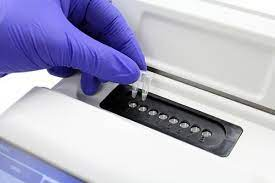
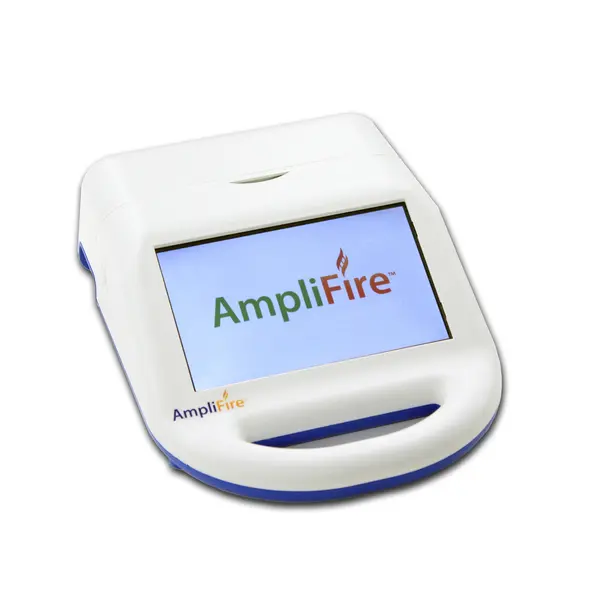
Distinct Benefits:
- Portable- battery operated mini device
- Sample preparation: Crushed plant tissue in buffer is used.
- Ready-to-use amplification reagents
- Pre-optimized and validated
- Real-time results in 30 minutes or less
- Lower equipment cost than PCR / qPCR
| Advantages of AmplifyRP® XRT | ||||||
| Special feature | PCR/ RT-PCR | AmplifyRP | ||||
|---|---|---|---|---|---|---|
|
Nature of sample |
Nucleic acid need to be extracted from sample |
Crude sample- Crushed plant tissue in buffer |
||||
|
Technical- ease |
Inhibition, fidelity, non-specific amplification, primer dimer, etc… |
Simple robust procedure which is devoid of these challenges |
||||
|
Easy procedures with narrow chances for error |
Lengthy and time consuming procedure with complicated preparations with the higher likelihood for error at each stage of the procedure. |
Simple procedure with all the reagents assorted in single kit. |
||||
|
Flexible assay reading |
Require specific, economic machine |
You can perform your assays with fluorometer*, existing RT-PCR* machines and AmpliFire® Isothermal Fluorometer |
||||
|
User friendly |
Need to setup the protocol manually |
Integrated barcode scanner automatically loads protocols |
||||
|
Processing time |
Few hours |
Sample to result- 30 minutes |
||||
|
Data interpretation |
Manual |
Quick & automatic |
||||
|
Economy |
Expensive set up involving multiple equipment and reagents from sample processing till results. |
Cost friendly setup Economic process without involving sample processing cost. |
||||
|
Skill issues |
Highly skilled personals required |
Minimum skill level required |
||||
|
Portability |
Not portable and need sophisticated lab setup |
Portable and can be field deployed |
||||
*Kits are also compatible with other fluorometers such as Axxin T-8, Axxin T-16, Optigene Ginie II & Optigene Ginie III.
Please refer all AmplifyRP® XRT and XRT+ kits available
Please check the video below to learn more on AmplifyRP® XRT procedure.
AmplifyRP® Acceler8®
AmplifyRP® Acceler8® is a rapid RNA amplification and detection platform designed for field-based or laboratory testing of different plant pathogens. It is formulated to allow an end-point detection of amplified products using a lateral flow strip. This lateral flow strip is housed inside an Amplicon Detection Chamber that is specifically designed to prevent the escape of amplified products and thereby also prevent laboratory contamination. AmplifyRP® Acceler8®enables users to rapidly amplify RNA at a single operating temperature using only a crude sample extract. Amplified product is then tested in an Amplicon Detection Chamber where clear "yes / no" results are read visually on a lateral flow strip (much like a pregnancy test). The entire testing process can be completed in as little as 30 minutes
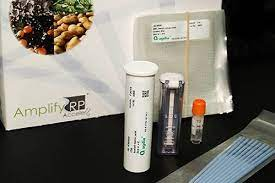
Please refer all AmplifyRP® Acceler8® tests kits available for various plant pathogens
Please check the video below to learn more on AmplifyRP® Acceler8® procedure.
Advantages of AmplifyRP® Acceler8®:
- Portable: Designed for field as well as laboratory setup.
- Unique feature: Lateral flow strip used for end point detection of amplified products.
- Contamination check: The amplicon detection chamber prevents any contamination.
- User friendly: Allow rapidly amplify RNA at a single operating temperature from crude sample and final result can be visualized on the lateral flow strip.
- Quick: Testing process can be completed in as little as 30 minutes.
- Skill level: Assay can be performed by users of all skill levels.
AmpliFire® Isothermal Fluorometer
AmpliFire is a portable, battery-powered, isothermal fluorometer that performs amplification and detection in as little as 10 minutes when paired with AmplifyRP XRT and XRT+ chemistry. Featuring an intuitive touch screen interface, integrated analysis software, and barcode scanning for protocol setup, the AmpliFire offers the ultimate ease of use!
Key Features:
- Easy portability enabled by small size and rechargeable battery that lasts up to six hours
- Up to eight samples per run
- Easy to use, full-color, touch screen interface
- Ten second scan time across three fluorescence channels
- Supports multiple isothermal chemistries

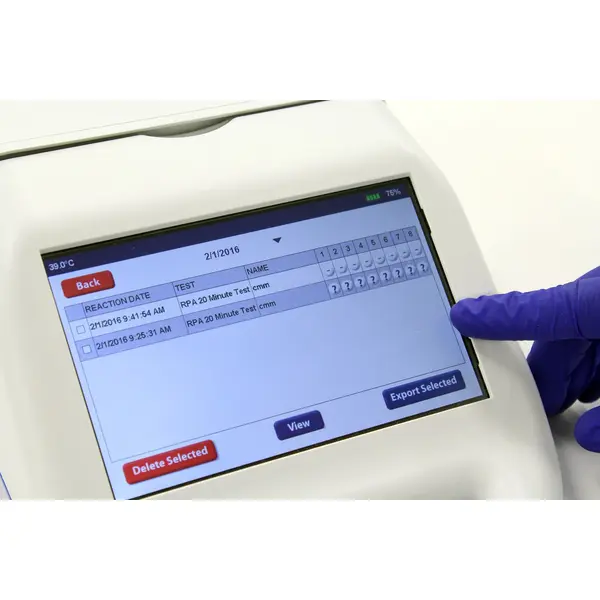
Benefits:
- Use in lab or field settings
- Crude sample preparation
- Rapid sample to answer functionality
- Light weight and small footprint
- Intuitive software workflow
Software and Data Analysis:
- Integrated barcode scanner automatically loads protocols
- Amplification curves displayed in real time
- Positive, negative, and indeterminate calls made automatically
- Supports multiple calling algorithms
- Detailed data export available in CSV format
Please check the video below to learn more on AmpliFire® Isothermal Fluorometer operating procedure.
Learn more about AmpliFire® Isothermal Fluorometer.
See what our customers say about AmpliFire® Isothermal Fluorometer and AmplifyRP®
QUESTIONS ABOUT AMPLIFYRP® ANSWERED FOR YOU!
What advantages does AmplifyRP® offer compared to conventional or real-time PCR?
Several! Although PCR is a highly sensitive and specific type of DNA testing, it does require some skill and is typically restricted to laboratory environments. In most PCR assays it is first required that suspect samples undergo a DNA purification or “clean-up” step. This step requires the use of expensive purification kits and sometimes toxic chemicals. PCR also requires an important step called thermal cycling where reactions are repeatedly subjected to temperature fluctuations that facilitate the actual PCR process. To summarize, PCR requires expensive equipment, skilled technicians, and several hours to complete.
AmplifyRP® provides a DNA testing platform that rivals PCR in terms of sensitivity and specificity, but it eliminates the need for expensive equipment and can be completed by users of all skill level all in about 30 minutes
- Crude extracts may be used for analysis
- Total assay time is between 25 and 40 minutes, including sample preparation
- Format is user-friendly and can be field portable
Do I need special training to use AmplifyRP®?
No. AmplifyRP® was designed with multiple types of end users in mind. All the reagents and disposable equipment necessary to run an AmplifyRP® test comes included in a kit. Any equipment required can be purchased upfront in a starter pack.
AmplifyRP® kits were also designed to limit the number of steps in the protocol. All the amplification reagents are lyophilized in one-time use tubes. The only thing the end user needs to do is rehydrate the reagents and insert their sample. Once that is complete, amplification and detection can be completed in 15 to 30 minutes depending on the format.
What part of my ground sample should I use to test?
With your sterile loop, please take your extract from the fully mixed sample solution. Do not add large pieces of tissue to the reaction.
Does this test include an internal reporter (housekeeping) control like some PCR reactions?
The control line in an Acceler8 assay is a measure of the performance of the lateral flow strip, not the nucleic acid extraction. Internal reporters or housekeeping primers are used in PCR reactions to detect the presence of host (plant) nucleic acid following nucleic acid purification. AmplifyRP® technology utilizes crude plant extracts and does not require any purification technique that could lead to the loss of host DNA or RNA, so internal reporters are not used.
Important Citations
1. Shulu Zhang, Michel Ravelonandro, Paul Russell, Nathan McOwen, Pascal Briard, Seven Bohannon, Albert Vrient. “Rapid diagnostic detection of plum pox virus in Prunus plants by isothermal AmplifyRP® using reverse transcription-recombinase polymerase amplification”. Journal of Virological Methods, 2014: (207) 114-120.
Link: https://www.sciencedirect.com/science/article/abs/pii/S0166093414002560
2. Hung K. Doan, Shulu Zhang, and R. Michael Davis. “Development and Evaluation of AmplifyRP Acceler8 Diagnostic Assay for the Detection of Fusarium oxysporum f. sp. vasinfectum Race 4 in Cotton”. The American Phytopathological Society (APS), 2014: (15) 48-52.
Link: https://apsjournals.apsnet.org/doi/abs/10.1094/PHP-RS-13-0115
3. Sophie Cesbron, Enora Dupas, and Marie-Agnès Jacques. “Evaluation of the AmplifyRP® XRT+ kit for the detection of Xylella fastidiosa by Recombinase Polymerase Amplification (RPA)”. The American Phytopathological Society (APS), 2022.
Link: https://apsjournals.apsnet.org/doi/abs/10.1094/PHYTOFR-03-22-0025-FI
4. Li, M.F. Fuchs, K.L. Perry, T. Mekuria and S. Zhang. “Development of a fast AmplifyRP Acceler8 Diagnostic Assay for Grapevine Red Blotch Virus”. Journal of Plant Pathology, 2017: (3) 657-662.
Link: https://www.jstor.org/stable/44687136
5. Paul F. Russell, Nathan McOwen, Seven Bohannon, Marcos A. Amato, Robert Bohannon. “Rapid on-site detection of the huanglongbing/citrus greening causal agent 'Candidatus liberibacter asiaticus' by AmplifyRP®, a novel rapid isothermal nucleic acid amplification platform”. XII International Citrus Congress - International Society of Citriculture. 2015
Link: https://www.actahort.org/members/showpdf?booknrarnr=1065_112
6. Natalia Kovalskaya, Rosemarie W. Hammond. “Rapid diagnostic detection of tomato apical stunt viroid based on isothermal reverse transcription-recombinase polymerase amplification”. Journal of Virological Methods, 2022: (300) 114353
Link: https://www.sciencedirect.com/science/article/pii/S0166093421002925
7. Rosemarie W. Hammond, Shulu Zhang. “Development of a rapid diagnostic assay for the detection of tomato chlorotic dwarf viroid based on isothermal reverse-transcription-recombinase polymerase amplification”. Journal of Virological Methods, 2016: (236) 62-67.
Link: https://www.sciencedirect.com/science/article/abs/pii/S0166093416301203

